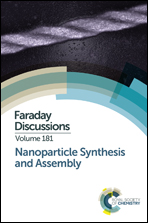Low-current field-assisted assembly of copper nanoparticles for current collectors†
Abstract
Current collectors are essential features of batteries and many other electronic devices being responsible for efficient charge transport to active electrode materials. Three-dimensional (3D), high surface area current collectors considerably improve the performance of cathodes and anodes in batteries, but their technological implementation is impeded by the complexity of their preparation, which needs to be simple, fast, and energy efficient. Here we demonstrate that field-stimulated assembly of ∼3 nm copper nanoparticles (NPs) enables the preparation of porous Cu NP films. The use of NP dispersions enables 30× reduction of the deposition current for making functional 3D coatings. In addition to high surface area, lattice-to-lattice connectivity in the self-assembly of NPs in 3D structures enables fast charge transport. The mesoscale dimensions of out-of-plane features and the spacing between them in Cu films made by field-stimulated self-assembly of NPs provides promising morphology for current collection in lithium ion batteries (LIBs). Half-cell electrochemical models based on self-assembled films show improved specific capacity, total capacity, and cycling performance compared to traditional flat and other 3D current collectors. While integration of active electrode material into the 3D topography of the current collector needs to be improved, this study indicates that self-assembled NP films represent a viable manufacturing approach for 3D electrodes.
- This article is part of the themed collection: Nanoparticle Synthesis and Assembly

 Please wait while we load your content...
Please wait while we load your content...